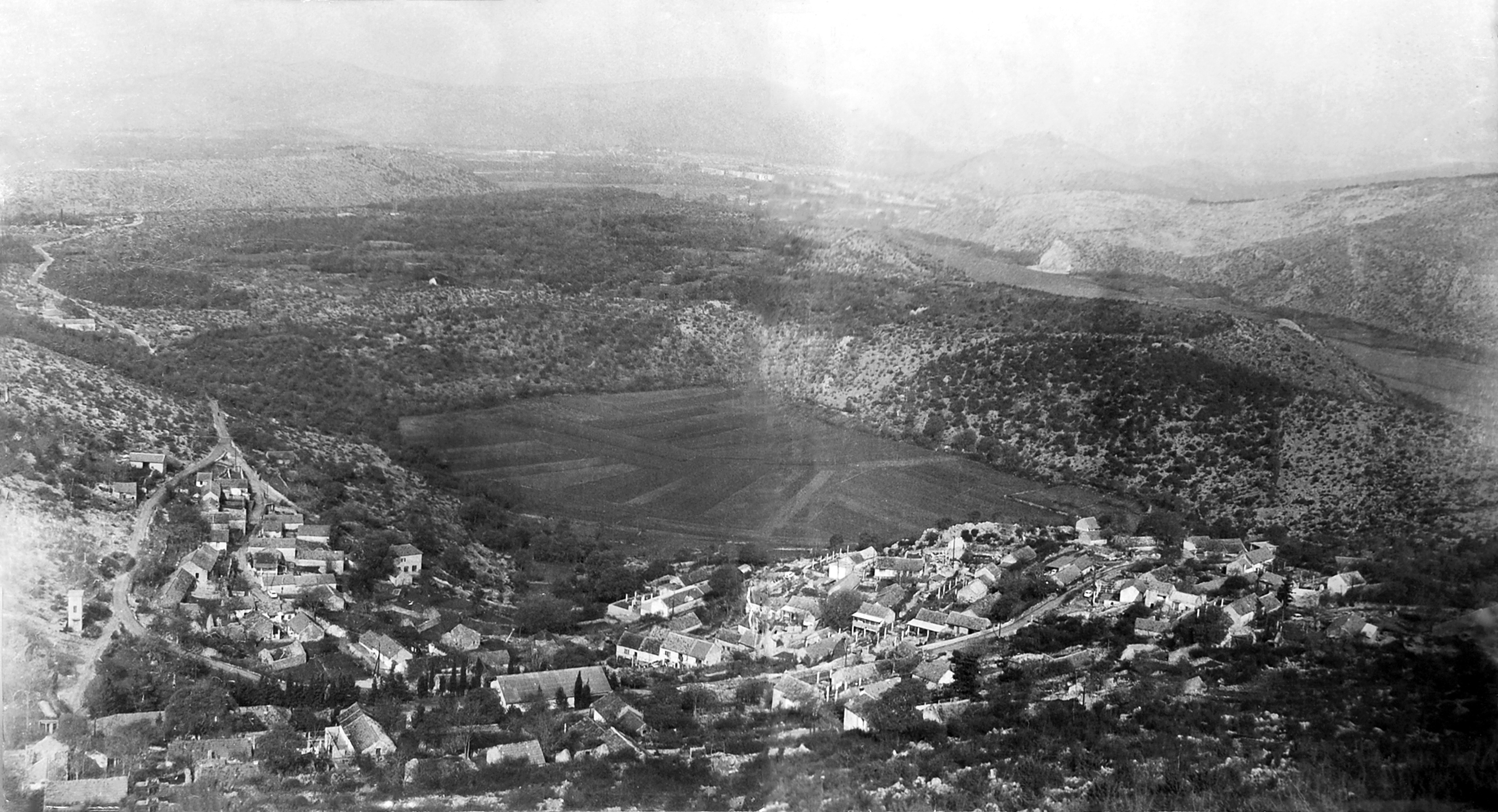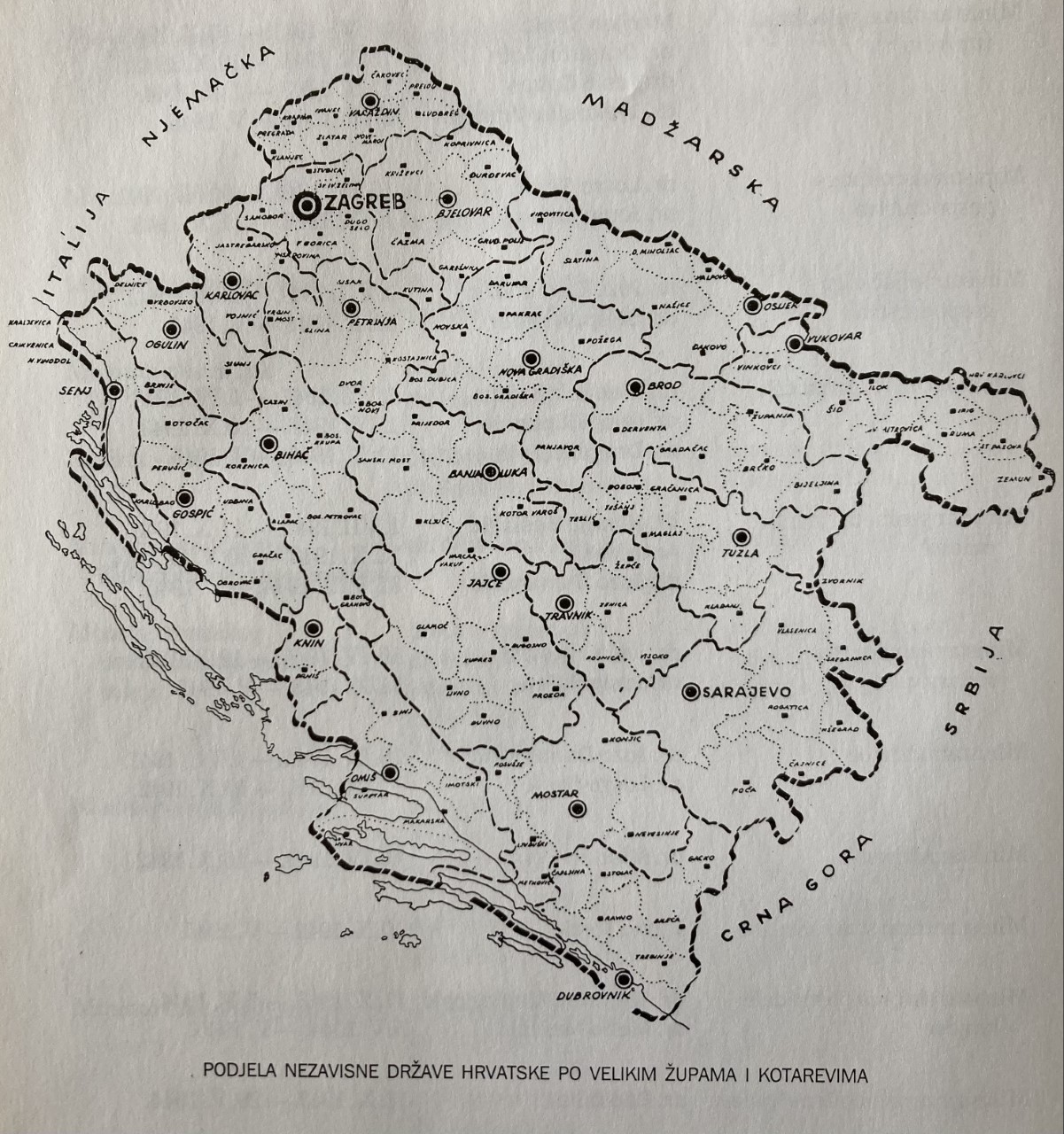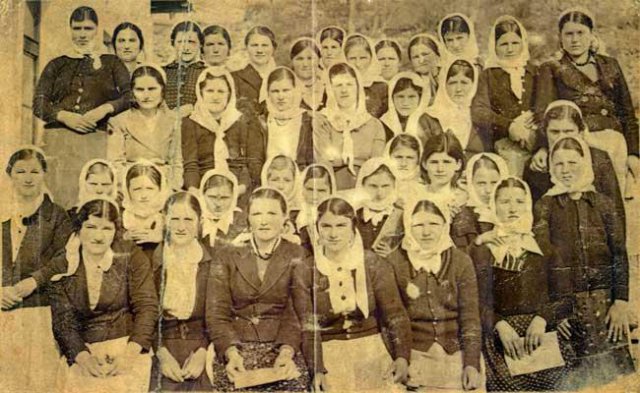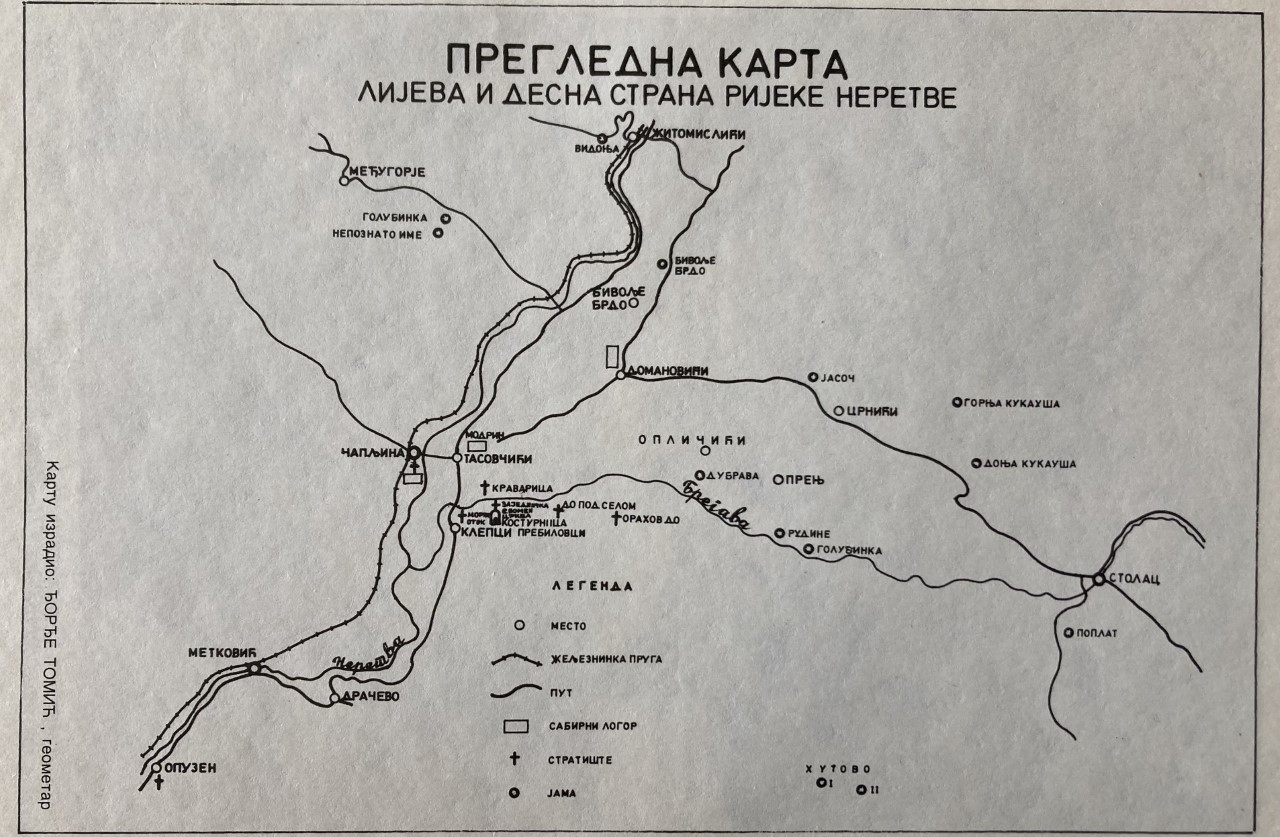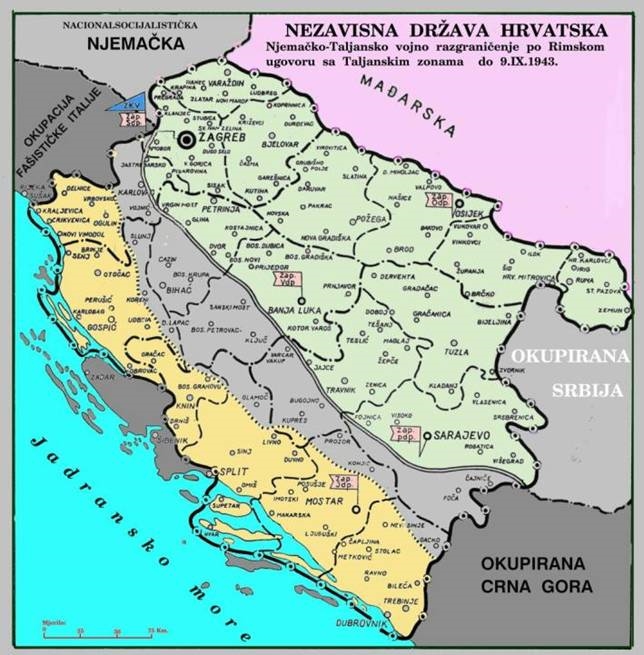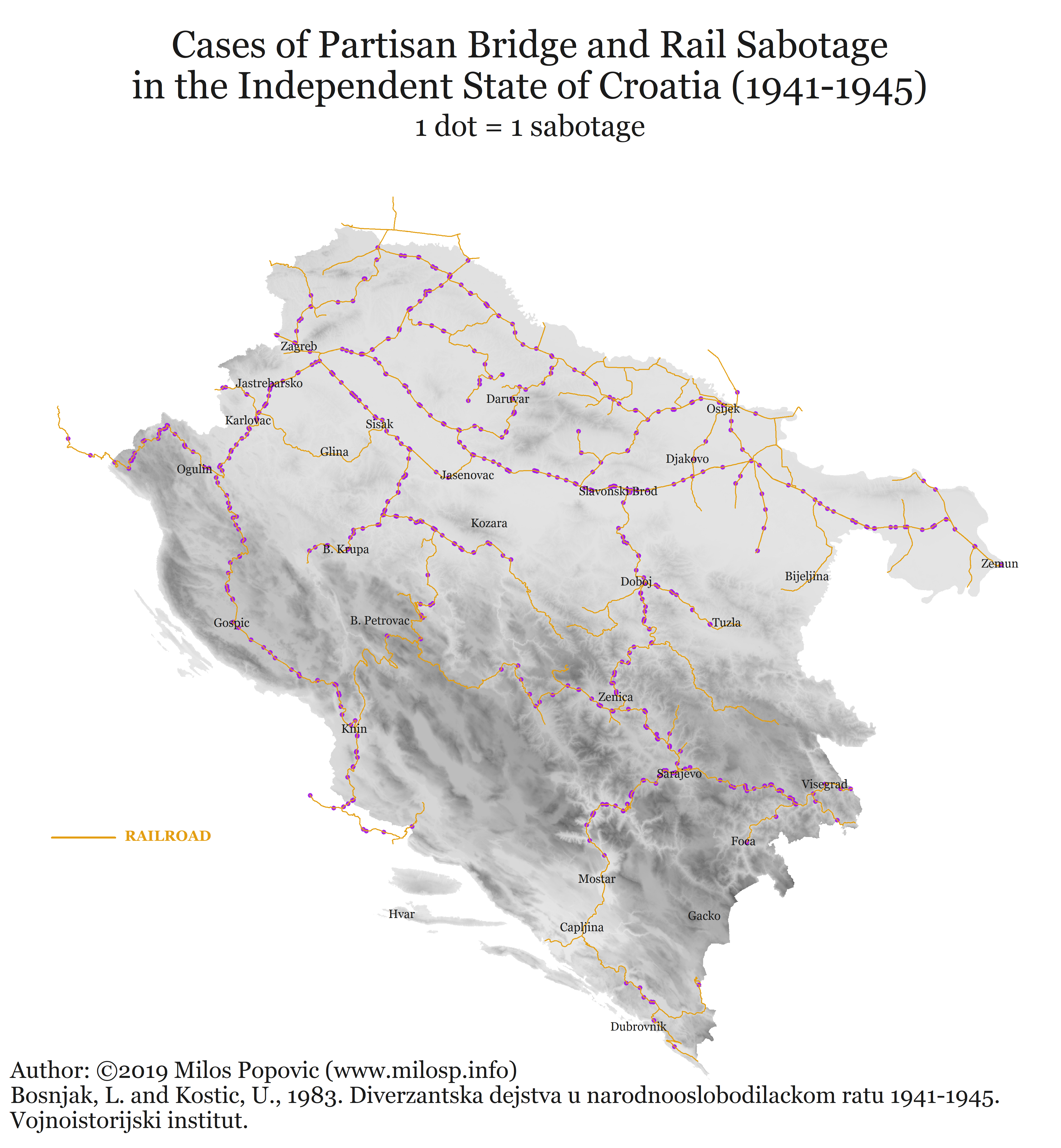Prebilovci – research implications for the NDH genocide against Serbs [1] [2]
[The photo in the header of the text, “Panorama of the village from 1974“; taken by: Aco Dragićević]
The crime in Prebilovci, an event known in detail to Serbs from Herzegovina, has become, again,[3] known to the general public after the broadcast of Sanja Dragićević's documentary film "Prebilovci, Еven a Stone Has a Scar There" in April of this year. Similar to the case of the film "Dara of Jasenovac" by Nataša Drakulić, the broadcast of the mentioned film on the Republic of Serbia’s public TV company encouraged many, both individuals whose roots are not from Herzegovina and representatives of various state institutions, local self-governments and non-governmental associations from Serbia and Montenegro, to take an interest in the fate of the villages near the left bank of the Neretva River, during the existence of the Independent State of Croatia (NDH). Coincidentally, or perhaps as a result of greater media visibility of Prebilovci, I was contacted by a journalist from a French news agency. At that point, my knowledge of the subject is superficial at best. Interested in the crime perpetrated within that Herzegovinian village, the representative of the newspaper company was interested in the authenticity of a certain text, as a historical source, whose circulation on social networks is viral, often cited, and especially linked to the crime in Prebilovci.[4]
From spring to the present moment – August 2022, period when the article in front of you was being written – time spent and dedicated to document research, their analysis, in parallel with the creation of the content for the audio exhibition "Prebilovci. Light in the Darkness", grew exponentially. In addition to the documents of the Kingdom of Italy, the Independent State of Croatia, the Serbian Orthodox Church, the District Court in Mostar from the time of socialist Yugoslavia, and the testimonies of survivors such as Mara Bulut, I had the opportunity to become acquainted with, for this topic, a significant corpus of scientific publications written by the pen of Herzegovinian Serbs.
By reviewing the mentioned publications, especially the research results of Savo Skoko, Milan Grahovac and Đuro Ekmečić, I gained a fairly clear insight into the chronological development of events in Herzegovina during 1941. Of course, the emphasis was on the crime in Prebilovci during August of that year.
On the other hand, structural explanations of the nature of the crimes against the Serbs in the NDH were noticeably absent, and thus also against the Serbs of Herzegovina, which is a chronic problem of domestic historiography and journalism. Conventional thinking on the topic of the genocide against the Serbs, at least until now, was reduced to: 1) the incomprehensible nature of the Ustasha crimes due to their brutality and the way they were carried out (an extremely wrong and dangerous interpretation, in my opinion) or 2) fascism and extreme nationalism as the ideological basis of the violence against Serbs (correct but not sufficient explanation, especially when explaining crimes like genocide).
Similarly, a sentence like this: "As a rule, mass crimes like genocide happen during an emergency i.e. state of war", may seem like a commonplace (tautological statement) and a conventional understanding of genocide; however, showing how, exactly, the state of war leads to a series of crimes whose total reaches the level of genocide is not a simple undertaking. On the other hand, it does not mean that we should not attempt to outline the conditions, the structural assumptions, which enable those type of crimes that with their prevalence, dynamics and nature constitute an attempt to destroy a nation.
With that in mind, on the following pages I will try to offer, actually outline, considering the platform and format, additional explanations with the aim of shedding light not only on the fate of women, children and the elderly, but also on the genocide of Serbs in the NDH. For this reason, I will first rely on the findings of my predecessors in order to introduce the readers, briefly, to the crime in Prebilovci.
Description of the Crime
In accordance with the format, the sketch of the crime will not be exhaustive, but rather indicative, since it assumes that most readers are not familiar with the event itself. Also, as mentioned, it will rely, to the greatest possible extent, on the above mentioned Skoko, Grahovac and Ekmečić’s research findings.
Preparation for the attack on Prebilovci, organized by the Čapljina camp commander Franjo Vega and his Ustashas,[5] began on August 2, 1941, with a field survey. In particular, Ustashas from Čapljina, the center of the same name district within the Great County of Dubrava (includes Dubrovnik with its hinterland, eastern and part of western Herzegovina), send two trucks of (oružnici) towards the village in order to gain insight into how the locals react. The gendarmerie did not fire, but were satisfied with the knowledge about the escape directions of the male population, as well as with the information on the passivity of women and children who were convinced that they were not the primary target. For this purpose, messages from the local Catholic parish priest – calls for home return, assurances that danger does not threaten the villagers – Don Ilija Tomas from Klepci (a neighbouring village), were also sent.
[Photo Division of NDH to great counties and districts“, taken by: Stefan Radojković; source of the photo: Darko Stuparić (ur.), Tko je tko u NDH. Hrvatska 1941 – 1945, Minerva, Zagreb, 1997, str. 460]
On the morning of August 4, the attack on the village starts from four directions – Hotanj, Čapljina, Gnjilište and Kruševo – in order to surround the village and prevent any escape attempt. When entering the village, several men were killed – most of them did not sleep at home but in the surrounding hills – while women, children and elderly people were concentrated in the building of the local elementary school "Kralj Milutin". Violence against women, especially the rape of the younger ones and girls, begins right here. Stana Arnaut, a local teacher, is one of the first victims. Mara Bulut, a witness of the suffering of the people of Prebilovci, also mentions Đuka Medić, Fimija Dragićević, Stoja Bulut, Olga Brnjašić and Mileva Bulut as victims of rape.
[Photo “Girls attending a Course in the Home Management (1939)“, source of the photo: Prebilovci – village on the internet]
On the evening of August 4, a group of imprisoned locals were taken on foot to the bridge on the Bregava River where trucks were waiting for them for transport to a nearby village, Tasovčići. After an overnight stay in the village, the women and children were transferred to the railway station in Čapljina where they were connected with a new group of Prebilovci residents, captured during the night of August 4-5. All in all, over 500 people are crammed into six cattle railcars in which they spend the whole day. It is an understatement to say that during the hot August day, due to thirst and lack of air, the detainees were additionally tortured. In the evening, taken over from Ustasha Division leader, Andrija Buljan and his 300 Ustashas, the composition of railcars arrives in the village of Šurmanci where they are welcomed by Ustasha Squad leader, Ivan Jovanović, together with people from Međugorje, Bijakovići and Šurmanci, total strength of about 150 people.
[Photo “Left and right bakns of the Neretva River“; taken by: Stefan Radojković; source of the photo: Đuro Ekmečić, Prebilovci, a never healing Serbian wound, Đ. Ekmečić, Beograd, 1994, str. 313]
At the railway station, more precisely the café within it, between Buljan and Jovanović, the manner of conducting detainees to the pit "Golubinka" where they will be thrown was agreed.[6] On the morning of August 6, the inhabitants of Prebilovci, classified in a column of four, were taken to the village of Šurmanci, i.e. to the place "Vranac" where the prisoners were deprived of all things of some value. After that, ustashas are divided into four groups, each with a specific task:
„[…] the first group, which in addition to the rifles also carried poles for drying tobacco, went to the pit "Golubinka", with the task of accepting victims there and pushing them into the pit with poles; The other group also went to the pit to knock down piles of rocks after each group of victims was thrown into the abyss.; the third group carried out the victims (in lots of 25 to 30 people) from the slope "Vranac" to some Smrdljika (a type of tree), about 40 meters away from the pit, where they were accepted by “pit throwers” and taken (again by lots of five to seven persons) to the edge of the pit and throw into a hatch; The fourth group guarded the victims on the "Vranac" slope until the last lot was taken away. The destruction of the inhabitants of the village of Prebilovci lasted for full six hours, from 7.30 to 1.30 p.m. These facts were established in the trial conducted at the District Court in Mostar against fourteen participants and direct perpetrators of that crime ..., in June 1957."[7]
The end of the Prebilovci suffering will follow in the days after the execution of women and children from Prebilovci – another 48 people (men) were killed in Morin Island, after surrendering to the Ustasha crew in the village between August 12 and 15, and at the end of August 20 more persons were deprived of the lives. According to Skoko's research, the winter of 1941, will be seen by 164 of the 994 people (population before the start of World War II[8] The culmination of the tragedy, certainly, took place near the village of Šurmanci, above the pit "Golubinka".
Without diminishing the severity of the crimes against the citizens of Prebilovci, especially against helpless children and women, on the following pages we turn to the analysis of the data presented both in the article itself so far, as well as other data that are even more and in more detail presented in the research of the three authors, with their addition to the Italian and NDH documents, testimonies of victims from Herzegovina and perpetrators of crimes in Prebilovci. The aim is to expand the image, so far focused exclusively on the mentioned village, to the Independent State of Croatia in order to sketch out those structural conditions that, unfortunately, contributed and, ultimately, enabled sufferings such as those experienced by the inhabitants of Prebilovci.
In other words, now is the time to adjust the optical devices so that the aforementioned crime, committed during the period 4-6 August 1941, is seen in the context of the Second World War in Europe, Yugoslavia and the NDH genocide perpetrated against Serbs. We believe that only in this way can we get a complete picture not only of the suffering of the people of Prebilovci, but also to sketch some of the structural assumptions of the suffering of the Serbian people in the mentioned state using the aforementioned case.
Relations between Italy and the Independent State of Croatia
Although they were the allies during the Second World War, Mussolini's Italy and Pavelić's NDH reached an agreement on the demarcation only on May 18, 1941, i.e. they concluded the Treaties of Rome which were preceded by the negotiations between Count Galeazzo Ciano and Joachim von Ribbentrop in Vienna (April, 21 and 22), between Ciano and Ante Pavelić in Ljubljana (April, 25) and in Tržič (May, 7). In short, relations between Italy and the NDH are regulated by the Treaties of Rome, of which, for our theme, the most important is the "Treaty on Issues of Military Importance, Relating to the Adriatic Coastal Area". More specifically, the following provision will have far-reaching consequences for the Serb population within the demilitarized zone under the rule of the NDH:
„The Croatian Government obliges itself not to raise or support on the islands and in the area between the sea and the line on the map attached, which forms an integral part of this Treaty, any military fortification or land, sea or air device, any military (operational) base or device that could be used for war purposes, or a factory or ammunition depot of warfare material."
In the literature, also known as the "second zone" – the "first zone" consists of parts of Dalmatia and the islands annexed by Italy, the "second" belongs to the NDH but without the presence of its army, while the "third zone" is a fully militarized part of the NDH – for fascist Italy it represents the guarantor of its domination over the Adriatic, and for Pavelić the price for the hospitality provided during the interwar period. The unintended, but certainly far-reaching, consequence of Italian policy for the Serbian population of the "second or demilitarized zone" of the NDH – the village of Prebilovci belongs there, too – is the complete absence of significant, official and state, armed formations in the area. Of course, since the Ustasha organization, together with its members, supporters and sympathizers, does not belong to the regular army of the NDH (Home Guard-domobrani, the name for regular military units), the provisions of the Treaties of Rome do not apply to it.
[Map “Independent State of Croatia“, taken over from the portal of Antifašistički Vijesnik, link: https://www.antifasisticki-vjesnik.org/hr/prenosimo/6/NDH_Nebus_Dugo_Hodil_/146/]
The first condition is right in front of us. The Ustasha organization, not only at the helm of the state and its armed formations present on the ground, has no serious competitor when it comes to monopolizing the use of force. Of course, the big question remains how much the Home Guard units would really be willing to oppose an organization that, in addition to its leading position in the state, has, at least initially, significant support from international factors – especially Nazi Germany – but also from the domestic, Croatian, population. Nevertheless, regardless of the question of the existence/absence of will of the Home Guard units for possible confrontation with armed Ustashas in order to maintain peace and order – or oružnici (regular gendarmerie formation of the NDH) who had an auxiliary role in the crime against the citizens of Prebilovci – precisely because of the unrestrained Ustasha violence, there was an uprising, of initially peaceful, Serb population.
The report of Lieutenant Colonel Josip Kopačin from Mostar, dated August 16, 1941 (to recall, ten days after the crime in Prebilovci and more than two months after the uprising of Serbs in Herzegovina), provides an insight into the situation on the ground:
„Two men armed with rifles came, one being in front and one at a few meters, and above the village stood also several armed men and looked after these two.
They said the following: They were not outlaws in reference to the authorities. They recognize the government and want to be at their homes but to be assured of life and survival. They did not flee from the authorities, but out of fear, because they were slaughtered and thrown alive into pits and were not allowed to cultivate the fields. They were invited by certain persons in the officers' suit to negotiate, to return home as no one would do anything to them and to freely cultivate the fields and that they did not need to fear anyone, but each time after that, the children, women and elderly people were attacked and captured and killed or thrown into pits [this refers to the villages of Prebilovci and Čavaš, author’s remark]. No one came to the village of Poljice because they defended – guarded the villages, but once before ustashas still came to the station and took two people, the postman and his son from his house."
The report of the aforementioned officer also describes a slightly higher level of trust of the rural population towards the army, gendarmerie and railway officials, that is the absence of the same towards the Ustashas. However, what we do not see from this report is how violence against Serbs has been carried out, and later intensified, since the establishment of a "second zone" in the NDH; simply put, "we have come to the scene" at a time when violence is at its peak. For this reason, we need to "go back in time" and analyze other, available, sources of information.
Infrastructure of Organized Ustasha’s Violence
Although the intentions of the Ustasha regime are superfluous to talk about, it is worth conveying the conversation between Alfio Russo, an Italian journalist, and Ante Pavelić at the end of April 1941, in Stevan K. Pavlović's book, Hitler's New Disorder; if nothing to distinguish between Zagreb's intentions and possible ways to implement them. When asked by Rousseau: "And what if all Serbs rebel?" Pavelić laconically replied: "Then we will kill them all." Desimir Mihić's testimony handed over to the Commissariat for Refugees and Migrants in Belgrade during March 1943 provides an insight into some of the ways of organizing The Ustasha authorities in the NDH, within the "second zone":
"Immediately after the arrival of German and Italian troops, Franjo Smole went to Stolac as an Ustasha commissioner, former director of the Croatian Peasants' Cooperative Bank, and then of the Muslim Bank. He started implementing the Ustasha organization in Stolac [within the Great County of Dubrava, District of Stolac is located right next to the District of Čapljina, where the village of Prebilovci is located, author’s remark], but soon left Stolac to return to it only when there was an agreement on demarcation between Italy and Croatia. […]
The rumours about the crimes of the Ustashas in Ljubinje and the district of Ljubinje began to arrive in Stolac and only then did fear begin to enter our lives. Commissioner Smole, however, claimed that this would not be allowed in his district as long as he was a commissioner and the Serbs were peaceful. […]
Two days after this event, Ustashas (at night) stormed the house of a respected Stolac craftsman, the virtuous and respectable Serb Gojko Pavić, a coppersmith, and took him under the pretext that the commissioner Smole was summoning him for questioning. No one had ever seen him afterwards, and his wife, when she came to Smole to ask him what happened with him, replied that he had not invited him or knew where he was. […]“
Analyzing the excerpt from the testimony of Desimir Mihić, we can notice a few things. Franjo Smole, commissioner of the Ustasha organization, comes, leaves and returns to Stolac after the aforementioned demarcation, which indicates coordination between different levels within the Ustasha organization. In other words, orders from Zagreb i.e. The Main Ustasha Command (GUS) is carried out on the ground. In this case, by sending commissioners from Zagreb to Stolac, the center of this very same, above named, district. Not coincidentally, law student Franjo Vego – one of the organizers of crimes against Serbs of Prebilovci, see The Description of the Crime section – was appointed as a commander of the Ustasha movement in Čapljina, the centre of the neighbouring district. The infrastructure of the Ustasha organization is branching out throughout the country, thus acquiring another condition for the implementation of the Zagreb intentions. In fact, Stevan K. Pavlović points to the fact that in most cases, during the first months of the NDH, the leadership within the smaller administrative units came "from outside", while the very elimination of the undesirable population was carried out by members and sympathizers of the Ustasha movement from the local area.
Here we need to draw attention to one more thing. The choice of the killing site of future victims was not due to coincidence. Indirectly, the site points not only to the infrastructure of the Ustasha organization, but also to other structural conditions that will be discussed more in the last section. For this reason, the conclusions of the verdicts of the District Court in Mostar to fourteen Ustashas led by Ivan Jovanović "Crni" from 1957 are of great importance.
In addition to being found guilty on several counts of the indictment, it was established that the pit "Golubinka" near Šurmanci was in use even before August 6, 1941. Namely, the first one accused, together with his accomplices, on several occasions – at least three times, during July 1941 – took over the arrested Serbs from Sarajevo and the surrounding area (Great County Vrhbosna) at the railway station in Šurmanci (Great County Dubrava). Upon transfer, the detainees were taken to the pit where they were liquidated and their bodies dumped. This shows the existence of communication, i.e. crime coordination, between the local leaders of the Ustasha movement (the village of Šurmanci, squad leader Ivan Jovanović "Crni", the city of Čapljina, division leader Andrija Buljan and the commander of the Čapljina district, Franjo Vego) and "external" officials, that is their counterparts in Sarajevo and the surrounding area which is. illustrating the established infrastructure of the Ustasha organization. Here it is not bad to remind the reader not only of the previous section on the crime in Prebilovci, but also of the text on the history of the Independent State of Croatia where we presented the establishment and the structure of the Ustasha movement.
Railway Infrastructure of NDH
Again not by chance, the author mentioned the railway of the Independent State of Croatia through the text in several places and in different contexts. This topic, although of immeasurable importance for understanding the manner of genocide perpetrated against Serbs, represents a poorly explored segment of the history of the NDH (honorable exceptions are, of course, Mihovilović's two-volume study of The Railwaymen in the Jasenovac concentration camp). In addition to representing the "tangible" presence of the state, its communication infrastructure, railways, as well as the telegraph, explain the way in which communication and coordination between the various organizational levels of the Ustasha movement were carried out. Unfortunately, the railway also enabled the implementation of genocide against Serbs in the NDH, i.e. it is a reliable indicator of the state project.
[Map “Cases of Partisan Bridge and Rail Sabotage in the Independent State of Croatia“, author: PhD Miloš Popović, link: https://milosp.info/maps/full/ndh_sabotage.png]
The Herzegovinian village of Šurmanci was not randomly selected, after all, nor was the Slavonian village of Jasenovac later and the prison in Gospić, before that. In addition to the fact that there is a remote pit "Golubinka" near the village, the railway infrastructure reaches the village aswell. Specifically, from Slavonski Brod, through Sarajevo and Mostar, all the way to Čapljina and Metković, there is a segment of the railway system of the NDH. Along the way, one railway line separates towards Šurmanci, just as one line of the Zemun-Slavonski Brod-Zagreb railway line separates towards Jasenovac. In short, it is possible to transport victims to locations remote enough – making it difficult for victims to escape while at the same time reducing the possibility of accidental witnesses – and equally easily accessible via the rail network.
In practice, it looks like this: "On the evening of August 4, a group of imprisoned locals were escorted on foot to the bridge on the Bregava River where trucks were waiting for them for transport to a nearby village, Tasovčići. After an overnight stay in the village, the women and children were transferred to the railway station in Čapljina where they were connected with a new group of Prebilovci residents, captured during the night of August 4-5. […] In the evening, taken over from the Ustasha Division leader Andrija Buljan and his 300 Ustashas, the composition of the railcars arrives in the village of Šurmanci where they are welcomed by the Ustasha Squad leader, Ivan Jovanovic, together with the men from Međugorje, Bijakovići and Šurmanci, total strength of about 150 people."
Unfortunately, until we get a research or, in turn, a film achievement of a reach anything like Lanzmann's monumental documentary movie Shoah, we are left to rely on individual case studies or sketches like this. However, we should not lack motive for such and other significant undertakings, because it is enough just to take into account the fact that the last detainees of the Gospić group of camps (Gospić-Pag-Jadovno) – at the same time the first prisoners of the Jasenovac camp complex – were brought to Jasenovac with the help of the railway infrastructure of the Independent State of Croatia.
[1] Stefan Radojković, historian and researcher-intern at the Institute for Political Studies from Belgrade.
[2] The article was originally and originally published for the Talas.rs internet portal in 2022, in two separate texts available via: https://talas.rs/2022/08/23/genocid-nad-srbina-u-ndh-slucaj-prebilovci-1-deo/; and: https://talas.rs/2022/09/22/genocid-nad-srbima-u-ndh-slucaj-prebilovci-2-deo/. NDH is the commonly known abbreviation for the Independent State of Croatia.
[3] I say again because the people of Prebilovci and the suffering of other Serb villages in Herzegovina during the Second World War, as a special topic, were in the focus of the public of the then Yugoslavia during November and December 1990 and at the beginning of 1991. For more information, watch Zdravko Šotra's documentary film "Here Are Our Children" from 1991: https://www.youtube.com/watch?v=yGky8nC1NQ8.
4 After analyzing the text and consulting with colleagues from Banja Luka and Belgrade, I pointed out to a journalist of the French news agency that "general Alessandro Luzano's letter" is the fruit of Vuk Drašković's fiction, created for the needs of the novel Молитва (В. Драшковић, Молитва, Књ. 2, Нова књига, Београд, 1986, стр. 42–51) (V. Drašković, “Prayer”, Book 2, Nova knjiga, Belgrade, 1986, pp. 42–51). Therefore, it is not a historical source (authentic document) but one of the legitimate and common forms of literary storytelling for the purposes of the novel, based on historical events.
[5] Here we again submit for inspection the manner and levels of organization of the Ustasha movement (squads, division, camp, headquarters and the Main Ustasha Command), in relation to the NDH administrative arrangement, available through: https://talas.rs/2021/04/09/kratka-istorija-nezavisne-drzave-hrvatske/#_ftn5.
[6] Description of the pit and the findings of speleologists from the end of 1990 are also available at: С. Скоко, Покољ херцеговачких Срба ’41, Стручна књига, Београд, 1991, стр. 196 и 19S. (Skoko, Massacre of Herzegovinian Serbs '41, Stručna knjiga, Belgrade, 1991, p. 196 and 198.).
[7] Ibid, p.195
[8] Ibid, p.204–206.

